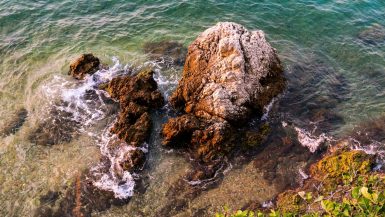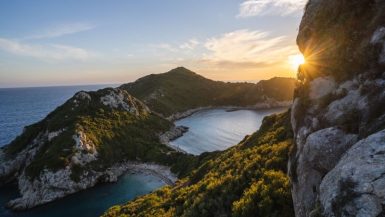
This guide to the warmest places in Greece will scour the home of feta and moussaka to seek out the spots where the thermometers soar higher than the Athenian Parthenon. We’ll aim to pick out the places where sun-seekers are sure to be pleased, no matter if they’re hunting for balmy beaches or sun-kissed mountain ranges.
The guide hops from the southerly isles of the Aegean Sea all the way to the untrodden peninsulas of Halkidiki in northern Greece. It’s got uber-famous holidaying spots with hotels by the water’s edge and more remote places that travelers are only just about discovering. The thing that ties them together is temperature – it should be hot throughout!
Of course, all of the warmest places in Greece will be warmer in the middle of the summer. However, the destinations listed below usually get nice and balmy by the early spring and won’t cool down again until the middle of autumn, making most fantastic options for early- or late-season vacations. Woohoo!
Crete

No list of the warmest places in Greece could possibly miss out on Crete. The most southerly and the largest of the Greek islands, it’s a place of true superlatives. It’s been drawing crowds of sun seekers for decades with its reliable weather and seemingly endless array of beaches – there are literally hundreds of coves and sand stretches on the menu here, from idyllic lagoons to palm-backed bays on the Libyan Sea.
Talking of the Libyan Sea, that’s the area we’re really on about when we wax lyrical about how hot Crete can get. Scoot down to the south coast and you’ll go from a Mediterranean climactic zone to a North African climactic zone. On top of that, the high Lefka Ori mountains help to create a bit of a rain shield and stop the Meltemi winds of summer coming through, upping the temperature even more. The result is a whole 200km stretch of coastline that’s some of the balmiest in the country.
The hottest areas of all lie around the Asterousia Mountains on the plains by the sea. There, it’s very possible to get regular highs of over 100 F, and things stay warm well into November (late season trip, anyone?). Tempted? We can recommend towns like Matala, a chilled hippy enclave, and Hora Sfakion, a canyon-shrouded fishing port with wonderful cheese pies.
Karpathos

Karpathos is often said to be the hottest of all the Greek islands. It’s one of the few places in the Aegean that manages to maintain an average monthly high that’s over 86 F (30 C) for two months in a row in the middle of summer, though actual peak temperatures can be closer to the 100 F mark! On top of that, Karpathos gets a minuscule 1mm of rainfall in the height of the season, so there’s hardly any cooling downpours to balance things out.
A member of the Dodecanese chain of islands, Karpathos is actually one of the more off-the-beaten-track spots in the region. But you only need to glimpse the map to see why it reigns as one of the warmest places in Greece. It’s almost the most southerly isle in the country, and pokes out very far east close to Turkey. That all helps it escape the cooler western weather systems that lurk over the other side of the Aegean.
Karpathos itself is a joy to explore. Long and thin, it’s known for its rock-ribbed mountain chain and kitesurfing beaches. During the height of the summer, there are often strong coast breezes to take the edge off the warmth. However, we recommend venturing through the forests inland, to wander time-stood-still Olymbos village and other homey hamlets.
Rhodes

From Karpathos, it’s not far on the ferry across the middle of the eastern Aegean to Rhodes. You’ll be sticking to the same hot corner of the Dodecanese islands, which means the temperatures aren’t all that different. Yep, thermometers on this famous holiday island still manage regular highs well above 100 F in the summer months, with record temperatures sitting at a scorching 106 F (41 C)!
The good news on Rhodes is that there are plenty of places to go to escape the heat. The whole southeastern shoreline is legendary in the world of travel brochure editing, because it offers a steady string of eye-wateringly lovely bays like Lindos and Red Sand Beach. That said, we also like the north coast for its breezier beaches, which also happen to be a lot less crowded in the height of the main season.
Rhodes remains a fantastic late- or early-season holiday hotspot. Daily means manage to creep up to the high 60s well into November and can start as early as April. We’d say spring is better for those on the hunt for history, of which Rhodes has stacks in the form of UNESCO Crusader castles and ancient temples. Autumn is more suited to beach lovers, because the Aegean is always warmer later in the year.
Zakynthos

Zakynthos isn’t the hottest island in Greece, but it might just be the hottest island in the Ionian part of Greece. This western region tends to be just a touch cooler than out east on the Turkish coast, but it’s still pretty darn balmy and has enough in the mercury levels to suit most sun-seeking travelers. One way to crank up the temperature even more is to head south in the chain, which is where you find buzzy Zante and its exquisite coastline.
It’s normal for temperatures to hover around the 60s-80s mark for most of the spring, summer, and autumn. It will only get cooler than that for about five months of the year, between November and March. One nuance is that July trumps August as the hottest month here. Peaks then can get to 108 F (42.2 C), compared to 101 F highs only 30 days later.
Zakynthos is great in the sun, too. Most visitors will know about the jaw-dropping sights of Shipwreck Beach (surely one of the most photographed beaches in the world). But what about the protected marine lagoons around Turtle Island? What about the strange hot springs that gurgle from the ground around Xigia Sulfur Beach up north?
Diaporos

Diaporos is a tiny speck of land that fragments off the middle peninsula of Halkidiki in northern Greece. Despite only being about one square mile in size, it’s famed for its crystal-clear waters and reefs, which draw in intrepid snorkelers and swimmers every year. One of the reasons that they’re so good for travelers looking to get wet is that they seem to be pretty warm for much of the calendar.
The reason for that is the natural protection that’s offered by wide Vourvourous Bay just across the strait. That shelters Diaporos from the dominant N-NW winds that filter down from the mountains of the Balkans throughout much of the year, taking away any cooling breezes that roll across the shores. The result? H2O that sits between 63-73 F throughout the entire year. Nice.
The only downside we can think of is that Diaporos isn’t the easiest island to get to. You’ll need to hitch a ride with a local fisherman and then sail across. However, the whole of central Halkidiki and the peninsula of Sithonia is a beach lover’s dream come true, with all sorts of dune-backed bays for sunbathing and wild swimming.
Hydra

Hydra is a finger-long spit of an island that strings along the south side of the Peloponnese. It’s gained fame as a bit of a jet-setter escape from Athens, and as something of an off-beat artist’s colony – Leonard Cohen wrote some of his most iconic songs from one of the old cottages in the harbor, you know!
We also think it deserves a mention on this list of the warmest places in Greece. That’s not because it has some superlative climate. Not because it’s home to some strange microclimate. Instead, it’s one of the barest isles we’ve been to. All rust-red rock and stone, it rises straight from the end of the Saronic Gulf to the exposed peak of Mount Eros.
Yep, it’s tricky to find shade in these parts, especially if you hike the coastal trails along the beautiful northern shoreline or up into the Hydra highlands. There’s an upshot there for scuba folk, though, as the rocky coastline means there’s great visibility in the water. Couple that with warm summer and autumn days that are regularly 65-85 F and you’ve got a diver’s mecca.
Athens

Last but most certainly not least, we’ve got the buzzing, thrumming capital of the country. This sprawling cityscape reigns as one of the warmest places in Greece because it can get truly balmy in the height of the summer. That’s not so much down to any climactic phenomenon – Athens gets pretty much the same weather as surrounding Attica. It’s more down to the warming effect of the urban architecture and traffic.
Tourists flocking to see sights like the Parthenon and the Acropolis Hill archaeological dig would do well to start their tours early on in the day if traveling between May and August. Not only will that help to dodge the crowds but means you might be able to skip the soaring midday mercury levels, which can easily peak above 100 F (37 C) and maintain that level for several hours on end.
The thing is, there are signs that the almost unbearable city heat in Athens is getting worse. The hottest ever recorded temperature in the ancient city was set only in 2007, when thermometers hit a marble statue-cracking 112.6 F (44.7 C). That was the hottest it’s been here in at least 160 years, which is when records began. No wonder so many of the locals now choose to escape to the so-called Athenian Riviera beaches just to the south of the downtown.
So, where are the warmest places in Greece?
The warmest places in Greece are actually all over. We’ve picked out southerly islands with one foot in the North African climactic zone and bustling mainland cities alike. The good news is that most places in Greece are pretty warm, provided you visit sometime in the main season between May and September. However, there are some spots where thermometers can clock over 100 F for days and days in a row, and where you’ll get to enjoy extra sunshine with hardly a drop of rain to boot.


